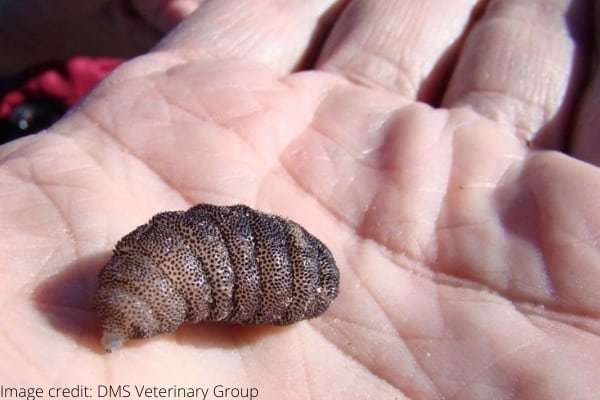
Wolf worms, or as they’re scientifically labeled, *larvae of the bot fly*, seem to thrive in specific seasons, often making their presence felt in the warmer months. Just like some animals hibernate or migrate, wolf worms seem to follow the rhythm of nature.
What Are Wolf Worms?
To really understand wolf worms, let’s break down what they are. Essentially, these are the larvae of the **cutaneous myiasis**, a type of bot fly. When adult bot flies lay their eggs on or near a host animal—like a wolf, hence the name—they can burrow into the skin as they hatch. It’s kind of like having a parasite that has its own unique life cycle, and it all starts with those eggs.
You might be wondering how these little guys actually affect their hosts. Once they hatch, the larvae migrate beneath the skin, creating a painful, swollen lesion. This is often where the term “wolf worm” comes into play since they can cause discomfort and distress for their host. Animals, especially livestock and pets, can end up with serious skin infections if not treated properly.
For the most part, wolf worms are specific to certain regions, especially in warmer climates. Understanding where they thrive is essential for prevention and control.
How Do Seasonal Patterns Affect Wolf Worms?
Just like how we notice certain animals more during the spring or summer, wolf worms also have their own seasonal patterns. They tend to peak in warmer months, which usually coincides with their breeding cycles. Think of it this way: as the temperature rises, more host animals are outdoors, making it the perfect time for bot flies to lay their eggs.
In spring, you might start to see an increase in bot flies buzzing around, while summer usually brings the highest rates of wolf worm infestations. During this time, the larvae grow and develop. As cooler weather sets in during fall, the instances of infestations start to taper off dramatically.
This seasonal behavior is crucial for both wildlife and pet owners to understand. Being aware of this pattern can help you keep an eye out for any signs of infestation, especially during the warmer months when the risk is higher.
Signs of Wolf Worm Infestation in Animals
If you suspect your pet might have a wolf worm infestation, it’s essential to be vigilant for certain signs. Here’s what to look for:
- Swelling or Lumps: The most noticeable symptom is swelling under the skin. You may find uncomfortable lumps on your pet.
- Skin Irritation: Pets often scratch or bite at the affected area, leading to redness and irritation.
- Foul Odor: Infected areas might smell bad, which can indicate bacterial infections.
- Behavior Changes: Your pet could become more lethargic or irritable due to discomfort.
If you spot any of these signs, it’s time to act. Ignoring these symptoms can lead to serious health problems for your pet, including abscesses or more severe infections.
Preventing Wolf Worm Infestations
Preventing wolf worms starts with understanding their life cycle and being vigilant, especially during peak season. Here are some simple preventive measures you can take:
- Regular Check-ups: Take your pets for regular veterinary check-ups to catch any potential issues early.
- Grooming: Regular grooming can help you spot any lumps or unusual skin issues before they become serious.
- Avoid Problem Areas: Try to keep pets away from heavily infested areas, especially in warmer months.
- Pest Control: Consider using a professional pest control service if you live in an area prone to bot flies.
By being proactive, you can help protect your favorite furry friends from the discomfort of wolf worms.
Treating Wolf Worm Infestations
If you suspect that your pet is infested with wolf worms, the first step is to consult your veterinarian. Treatment usually involves a few key steps:
1. **Diagnosis**: The vet will examine your pet and may recommend tests to confirm the presence of larvae.
2. **Removal**: If wolf worms are confirmed, your vet may need to remove the larvae surgically, especially if they are deeply embedded.
3. **Medication**: Post-removal, your pet might need antibiotics to prevent infections.
4. **Follow-up**: It’s important to monitor the area for any signs of recurring problems and to ensure your pet is healing properly.
Treating wolf worms promptly can make all the difference in your pet’s recovery, so don’t hesitate to seek help.
Understanding the Impact on Wildlife and Livestock
Wolf worms aren’t just a concern for pets—wildlife and livestock can suffer too. Infestations can lead to severe discomfort, slow healing, and even decreased productivity in farm animals, which translates to economic losses for farmers.
In wild animals, infestations can impair feeding or lead to increased vulnerability to predators. This not only affects individual animals but can also impact entire species. When these parasites thrive, they can disrupt local ecosystems, creating ripple effects throughout the food chain.
Protecting your livestock and wildlife from wolf worms involves similar prevention strategies—keeping animals healthy, regular checks for signs of infestation, and maintaining clean environments.
Understanding wolf worms and their seasonal infestation patterns is crucial for pet owners, farmers, and wildlife enthusiasts alike. By recognizing the signs, preventing infestations, and seeking timely treatment, you can ensure the health and happiness of your animals. Remember, being informed and proactive can make a world of difference. So, whether you’re in a rural area or just love your pets, keeping an eye out for these little invaders can help keep your loved ones safe and healthy.
